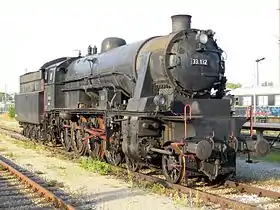BBÖ 113
The BBÖ 113 was a class of 40 express train, 4-8-0 tender locomotives operated by the Federal Railway of Austria (Bundesbahnen Österreichs, BBÖ).
| BBÖ 113 DRB 33.1 ÖBB 33 | |
|---|---|
 Locomotive 33.132 in 2011 | |
| Number(s) |
|
| Quantity | 40 |
| Manufacturer | |
| Year(s) of manufacture | 1923–1928 |
| Retired | 1968 |
| Wheel arrangement | 4-8-0 |
| Axle arrangement | 2′D h2 |
| Track gauge | 1,435 mm (4 ft 8 1⁄2 in) |
| Length over buffers | 20,698 mm (67 ft 11 in) |
| Length | 17,242 mm (56 ft 6 3⁄4 in) |
| Height | 4,650 mm (15 ft 3 1⁄8 in) |
| Wheelbase | 3,700 mm (12 ft 1 3⁄4 in) |
| Overall wheelbase | 9,540 mm (31 ft 3 1⁄2 in) |
| Wheelbase incl. tender | 17,174 mm (56 ft 4 1⁄4 in) |
| Service weight | 85.2 t (83.9 long tons; 93.9 short tons) |
| Adhesive weight | 59.4 t (58.5 long tons; 65.5 short tons) |
| Top speed | 100 or 85 km/h (62 or 53 mph) |
| Driving wheel diameter | 1,740 mm (5 ft 8 1⁄2 in) |
| Leading wheel diameter | 1,034 mm (3 ft 4 3⁄4 in) |
| No. of cylinders | 2 |
| Cylinder bore | 560 mm (22 1⁄16 in) |
| Piston stroke | 720 mm (28 3⁄8 in) |
| Boiler length | 9,966 mm (32 ft 8 1⁄4 in) |
| Boiler Overpressure | 15 kgf/cm2 (1.47 MPa; 213 lbf/in2) |
| No. of heating tubes | 151 |
| No. of smoke tubes | 32 |
| Heating tube length | 5,200 mm (17 ft 3⁄4 in) |
| Grate area | 4.47 m2 (48.1 sq ft) |
| Radiative heating area | 16.10 m2 (173.3 sq ft) |
| Tube heating area | 187.90 m2 (2,022.5 sq ft) |
| Superheater area | 69.5 m2 (748 sq ft) |
| Tender | 85 |
| Water capacity | 27.0 m3 (950 cu ft) |
| Fuel | 7.44 m3 (263 cu ft) of coal |
History
After World War I new locomotives had to be built for the Austrian Western Railway due to increasing train loads and the replacement of old, wooden, passenger coaches with steel-bodied coaches. A 4-8-0 design was chosen which was based in many respects on the Class 570 of the Austrian Southern Railway, but which, at the same time, had numerous improvements. Between 1923 and 1928 40 locomotives of this new Class 113 were taken into service with the BBÖ.
This class was very powerful and much liked by locomotive crews. It was employed on the most importance passenger train duties and in front of express and fast trains (Eilzüge) and fulfilled its role on main lines well until the end of the steam era, when its top speed of 85 km/h was no longer considered enough. In 1939, the Deutsche Reichsbahn took these locomotives over as DRG Class 33 101–140. In 1953 there were still 33 engines left in the ÖBB, their Reichsbahn numbers being retained. All were retired by 1968.
50 close copies were of Class 570 were built in Poland by Fablok and StEG, as PKP Class Os24. Class 113 was further developed in Hungary, where 514 MÁV Class 424 were built for Hungary, Yugoslavia and North Korea.
Preserved locomotives
Number 33.102 has been preserved for the Austrian Railway Museum (Österreichische Eisenbahnmuseum) and is based today at the Strasshof Railway Museum (Eisenbahnmuseum Strasshof) in Lower Austria. In the 1980s a preserved example in Yugoslavia was bought by private firm and restored to operational status. Today this engine has the fictitious number 33.132 and is available for heritage trips. A single Os24 locomotive exists in Poland, which can be regarded more as a Polish copy of the Class 570 predecessor.[1]
| Number | Built | Status | Owner/Location |
|---|---|---|---|
| 33.102 | 1923 | Exhibit | TMW / Strasshof Railway Museum |
| 33.132 | 1925 | Working | Brenner & Brenner / St. Pölten |
| Os24-39 | 1927 | Unrestored | Warsaw Railway Museum / Warsaw |
References
- "Os24". www.locomotives.com.pl. Retrieved 2020-04-08.
- Zoubek, Dieter (2004). Erhaltene Dampflokomotiven in und aus Österreich/Austrian preserved steam locomotives. Eigenverlag. ISBN 3-200-00174-7.CS1 maint: ref=harv (link)
